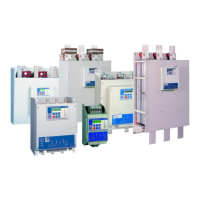87 • Control Keypad
________________________________________________________________________________________________
7.8 Non Adjustable Protection and Fault Reset
7.8.1 Under/Over Frequency
Operational when the RVS-DN is en
ergized and protects the motor when the frequency is less than 45 or
greater than 65Hz.
7.8.2 Phase Loss
Operational when the RVS-DN is en
ergized, provided this protection has not been de-activated. Phase loss
protection trips the RVS-DN when 1 or 2 phases are missing for more than 1 sec.
Refer to section
7.7.7 on page 81 parameter PHASE LOSS. Y/N.
7.8.3 Phase Sequence
Operational when the RVS-DN is en
ergized, provided this protection has not been de-activated. Phase
sequence protection trips the RVS-DN when phase sequence is wrong.
Refer to section 7.7.7 on page 81 parameter PHASE SEQ. Y/N.
7.8.4 Wrong Connection
Operational after start signal. Trips if
motor is not properly connected to the RVS-DN’s load terminals, when
internal disconnection is detected in the motor winding. This protection is not active when D. ADJ.:
GENERATOR PARAMETERS is selected.
7.8.5 Shorted SCR
Trips the RVS-DN if one or more of the SCRs have been shorted. This pr
otection is not active when D. ADJ.:
GENERATOR PARAMETERS is selected.
7.8.6 Heat-Sink Over Temperature
Thermal sensors are mounted on the
heat-sink and trip the RVS-DN when the temperature rises above 85ºC.
WARNING!
The over temperature protection is designed to operate under normal
conditions, e.g., in the event of extended low overload, insufficient ventilation
due to fan stoppage or air flow blockage.
Incorrect RVS-DN selection, frequent starting at max. conditions, or repeated
starting under fault conditions can cause the SCR to overheat and fail before
the heat-sink reaches 85°C thereby causing the thermal sensors to trip the
RVS-DN.
7.8.7 External Fault
External Fault becomes operational
when RVS-DN is energized.
The RVS-DN will trip if contact closes for more than 2 sec.
WARNING!
Do not use External Fault when terminal 21 is not connected to ground.
7.8.8 Fault and Reset
When any of the above protections (
except INSULATION ALARM) trip, the RVS-DN locks in a fault condition,
disabling firing of the thyristors. Fault LED lights, fault description is displayed on the LCD and the fault relay
operates.
• For local resetting, after fault has been removed, press Reset key.
• Remote resetting can be performed through terminals 7 or 8 (see I/O PROGRAMMING section
7.7.8 page 83).
When a fault occurs, followed by a voltage outage, the fault condition is latched and reappears upon voltage
restoration.
Note:

